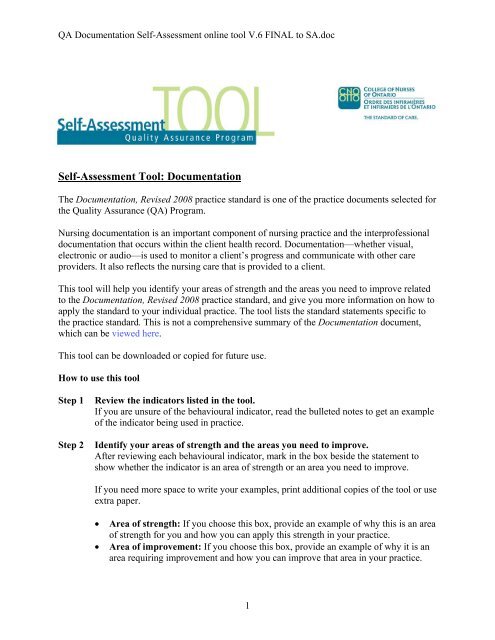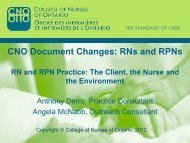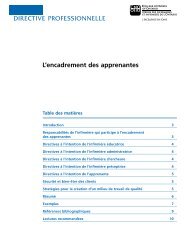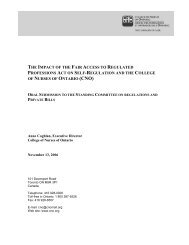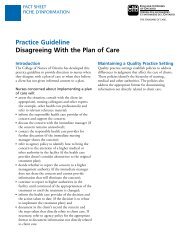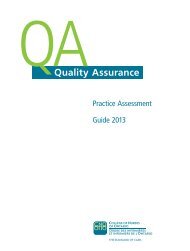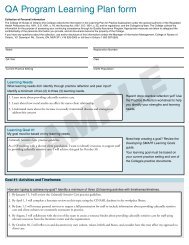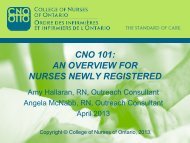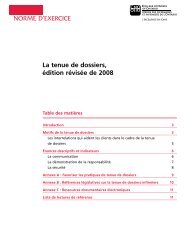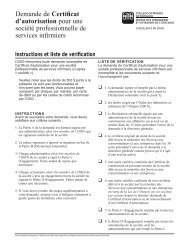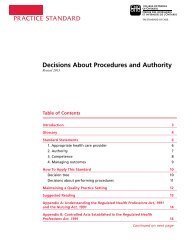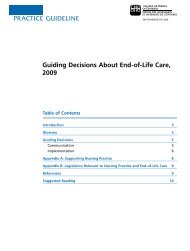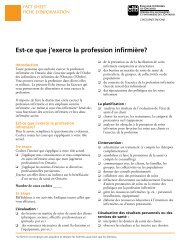Self-Assessment Tool: Documentation - College of Nurses of Ontario
Self-Assessment Tool: Documentation - College of Nurses of Ontario
Self-Assessment Tool: Documentation - College of Nurses of Ontario
You also want an ePaper? Increase the reach of your titles
YUMPU automatically turns print PDFs into web optimized ePapers that Google loves.
QA <strong>Documentation</strong> <strong>Self</strong>-<strong>Assessment</strong> online tool V.6 FINAL to SA.doc<br />
<strong>Self</strong>-<strong>Assessment</strong> <strong>Tool</strong>: <strong>Documentation</strong><br />
The <strong>Documentation</strong>, Revised 2008 practice standard is one <strong>of</strong> the practice documents selected for<br />
the Quality Assurance (QA) Program.<br />
Nursing documentation is an important component <strong>of</strong> nursing practice and the interpr<strong>of</strong>essional<br />
documentation that occurs within the client health record. <strong>Documentation</strong>—whether visual,<br />
electronic or audio—is used to monitor a client’s progress and communicate with other care<br />
providers. It also reflects the nursing care that is provided to a client.<br />
This tool will help you identify your areas <strong>of</strong> strength and the areas you need to improve related<br />
to the <strong>Documentation</strong>, Revised 2008 practice standard, and give you more information on how to<br />
apply the standard to your individual practice. The tool lists the standard statements specific to<br />
the practice standard. This is not a comprehensive summary <strong>of</strong> the <strong>Documentation</strong> document,<br />
which can be viewed here.<br />
This tool can be downloaded or copied for future use.<br />
How to use this tool<br />
Step 1 Review the indicators listed in the tool.<br />
If you are unsure <strong>of</strong> the behavioural indicator, read the bulleted notes to get an example<br />
<strong>of</strong> the indicator being used in practice.<br />
Step 2 Identify your areas <strong>of</strong> strength and the areas you need to improve.<br />
After reviewing each behavioural indicator, mark in the box beside the statement to<br />
show whether the indicator is an area <strong>of</strong> strength or an area you need to improve.<br />
If you need more space to write your examples, print additional copies <strong>of</strong> the tool or use<br />
extra paper.<br />
Area <strong>of</strong> strength: If you choose this box, provide an example <strong>of</strong> why this is an area<br />
<strong>of</strong> strength for you and how you can apply this strength in your practice.<br />
Area <strong>of</strong> improvement: If you choose this box, provide an example <strong>of</strong> why it is an<br />
area requiring improvement and how you can improve that area in your practice.<br />
1
QA <strong>Documentation</strong> <strong>Self</strong>-<strong>Assessment</strong> online tool V.6 FINAL to SA.doc<br />
Step 3 Use the information on the tool to develop learning goals that you can use in your<br />
Learning Plan.<br />
Once you have identified your areas <strong>of</strong> strength and the areas you need to improve, you<br />
can create your learning goals and start developing your Learning Plan.<br />
Use the Developing SMART Learning Goals guide to help you create goals that are<br />
specific, measurable, attainable, relevant and time-limited.<br />
Create your goal statement by starting with a phrase, for example:<br />
“I want to share my knowledge/expertise about …” (for areas <strong>of</strong> strength)<br />
“I want to work on/learn how to …” (for areas <strong>of</strong> improvement)<br />
Then add the applicable behavioural indicator that was noted as an area <strong>of</strong> improvement<br />
or strength. This information forms the basis for documenting activities for your<br />
learning goals.<br />
Remember to incorporate the following four elements in your self-assessment and the<br />
development <strong>of</strong> your Learning Plan:<br />
advances in technology;<br />
changes in the practice environment;<br />
entry-to-practice competencies; and<br />
interpr<strong>of</strong>essional care.<br />
2
QA <strong>Documentation</strong> <strong>Self</strong>-<strong>Assessment</strong> online tool V.6 FINAL to SA.doc<br />
Behavioural indicators<br />
Bullet points are examples <strong>of</strong> how the indicator<br />
can be applied in practice.<br />
Communication<br />
<strong>Nurses</strong> ensure that documentation presents an<br />
accurate, clear and comprehensive picture <strong>of</strong> the<br />
client’s needs, the nurse’s interventions and the<br />
client’s outcomes. You meet the standard by:<br />
Ensuring that documentation is a complete record<br />
<strong>of</strong> nursing care provided and reflects all aspects <strong>of</strong><br />
the nursing process, including assessment,<br />
planning, intervention (independent and<br />
collaborative) and evaluation.<br />
Documenting both objective and subjective data.<br />
Ensuring that the plan <strong>of</strong> care is clear, current,<br />
relevant and individualized to meet the client’s<br />
needs and wishes.<br />
Minimizing duplication <strong>of</strong> information in the<br />
health record.<br />
Documenting significant communication with<br />
family members/significant others, substitute<br />
decision-makers and other care providers.<br />
Ensuring that relevant client care information kept<br />
in temporary hard copy documents (such as<br />
kardex, shift reports or communication books) is<br />
captured in the permanent health record. For<br />
example, if the electronic system is unavailable,<br />
the nurse must ensure that information captured in<br />
temporary documents is entered in the electronic<br />
system when it becomes available.<br />
Providing a full signature or initials, and<br />
pr<strong>of</strong>essional designation (RPN, RPN[Temp], RN,<br />
RN[Temp] or NP) with all documentation.<br />
Providing full signature, initials and designation<br />
on a master list when initialing documentation.<br />
Ensuring that hand-written documentation is<br />
legible and completed in permanent ink.<br />
<strong>Self</strong>-<strong>Assessment</strong> <strong>Tool</strong>: <strong>Documentation</strong><br />
Identify whether the behavioural indicator is an area <strong>of</strong><br />
strength, with an example, or an area you need to improve,<br />
with an example <strong>of</strong> how that area can be improved.<br />
Area <strong>of</strong> strength Area you need to improve<br />
3
QA <strong>Documentation</strong> <strong>Self</strong>-<strong>Assessment</strong> online tool V.6 FINAL to SA.doc<br />
Behavioural indicators<br />
Bullet points are examples <strong>of</strong> how the indicator<br />
can be applied in practice.<br />
Using abbreviations and symbols appropriately by<br />
ensuring that each has a distinct interpretation and<br />
appears in a list with full explanations approved<br />
by the organization or practice setting.<br />
Documenting advice, care or services provided to<br />
an individual within a group, groups,<br />
communities or populations (for example, group<br />
education sessions).<br />
Documenting the nursing care provided when<br />
using information and telecommunication<br />
technologies (for example, providing telephone<br />
advice).<br />
Documenting informed consent when the nurse<br />
initiates a treatment or intervention authorized in<br />
legislation.<br />
Advocating for clear documentation policies and<br />
procedures that are consistent with the <strong>College</strong>'s<br />
practice standards.<br />
Adhering to <strong>College</strong> standards and organizational<br />
policies by not falsifying client records, including<br />
not signing or issuing a document that the<br />
member knows includes a false or misleading<br />
statement.<br />
Accountability<br />
<strong>Nurses</strong> are accountable for ensuring their<br />
documentation <strong>of</strong> client care is accurate, timely<br />
and complete. You meet the standard by:<br />
Documenting in a timely manner and completing<br />
documentation during, or as soon as possible<br />
after, the care or event.<br />
Documenting the date and time that care was<br />
provided and when it was recorded.<br />
Documenting in chronological order.<br />
Indicating when an entry is late as defined by<br />
organizational policies.<br />
Identify whether the behavioural indicator is an area <strong>of</strong><br />
strength, with an example, or an area you need to improve,<br />
with an example <strong>of</strong> how that area can be improved.<br />
Area <strong>of</strong> strength Area you need to improve<br />
4
QA <strong>Documentation</strong> <strong>Self</strong>-<strong>Assessment</strong> online tool V.6 FINAL to SA.doc<br />
Behavioural indicators<br />
Bullet points are examples <strong>of</strong> how the indicator<br />
can be applied in practice.<br />
Documenting at the next available entry space<br />
and not leaving empty lines for another person to<br />
add documentation (when using paper<br />
documentation forms). If there are empty lines,<br />
the nurse should draw a line from the end <strong>of</strong> the<br />
entry to the signature. When using an electronic<br />
system, the nurse should refrain from leaving<br />
space in a free-flow text box.<br />
Correcting errors while ensuring that the original<br />
information remains visible/retrievable.<br />
Never deleting, altering or modifying anyone<br />
else’s documentation.<br />
Enabling a client to add his or her information to<br />
the health record when there is a disagreement<br />
regarding care.<br />
Documenting when information for a specific<br />
time frame has been lost or cannot be recalled.<br />
Indicating clearly when an entry is replacing lost<br />
information.<br />
Ensuring that documentation is completed by the<br />
individual who performed the action or observed<br />
the event, except in situations when there is a<br />
designated recorder, who must sign and indicate<br />
the circumstances (for example, a code situation,<br />
or instances when an electronic system has<br />
technical difficulties and someone else enters the<br />
information when the system becomes available<br />
again).<br />
Clearly identifying the individual performing the<br />
assessment and/or intervention when<br />
documenting.<br />
Advocating for clear documentation policies and<br />
procedures at the nurse’s facility that are<br />
consistent with the <strong>College</strong>’s standards.<br />
Identify whether the behavioural indicator is an area <strong>of</strong><br />
strength, with an example, or an area you need to improve,<br />
with an example <strong>of</strong> how that area can be improved.<br />
Area <strong>of</strong> strength Area you need to improve<br />
5
QA <strong>Documentation</strong> <strong>Self</strong>-<strong>Assessment</strong> online tool V.6 FINAL to SA.doc<br />
Behavioural indicators<br />
Bullet points are examples <strong>of</strong> how the indicator<br />
can be applied in practice.<br />
Security<br />
<strong>Nurses</strong> safeguard client health information by<br />
maintaining confidentiality and acting in<br />
accordance with information retention and<br />
destruction policies and procedures that are<br />
consistent with the standard(s) and legislation.<br />
You meet the standard by:<br />
Ensuring relevant client care information is<br />
captured in a permanent record.<br />
Maintaining confidentiality <strong>of</strong> client health<br />
information, including passwords or information<br />
required to access the client health record.<br />
Understanding and adhering to policies, standards<br />
and legislation related to confidentiality.<br />
Accessing only information for which the nurse<br />
has a pr<strong>of</strong>essional need to provide care.<br />
Maintaining the confidentiality <strong>of</strong> other clients by<br />
using initials or codes when referring to another<br />
client in a client’s health record (for example,<br />
using initials when quoting a client’s roommate).<br />
Facilitating the rights <strong>of</strong> the client or substitute<br />
decision-maker to access, inspect and obtain a<br />
copy <strong>of</strong> the health records, unless there is a<br />
compelling reason not to do so (for example, if<br />
disclosure could result in a risk <strong>of</strong> serious harm to<br />
the treatment or recovery <strong>of</strong> an individual).<br />
Obtaining informed consent from the client or<br />
substitute decision-maker to use and disclose<br />
information to others outside the circle <strong>of</strong> care.<br />
Using a secure method such as a secure line for<br />
fax or e-mail to transmit client health information<br />
(for example, making sure the fax machine is not<br />
available to the public).<br />
Retaining health records for the period the<br />
organization’s policy and legislation stipulates<br />
when required by the nurse’s role (for example, in<br />
independent practice).<br />
Ensuring the secure and confidential destruction<br />
<strong>of</strong> temporary documents that are no longer in use.<br />
Identify whether the behavioural indicator is an area <strong>of</strong><br />
strength, with an example, or an area you need to improve,<br />
with an example <strong>of</strong> how that area can be improved.<br />
Area <strong>of</strong> strength Area you need to improve<br />
6
QA <strong>Documentation</strong> <strong>Self</strong>-<strong>Assessment</strong> online tool V.6 FINAL to SA.doc<br />
Behavioural indicators<br />
Bullet points are examples <strong>of</strong> how the indicator<br />
can be applied in practice.<br />
Advocating for clear documentation policies and<br />
procedures that are consistent with the <strong>College</strong>’s<br />
standards.<br />
Identify whether the behavioural indicator is an area <strong>of</strong><br />
strength, with an example, or an area you need to improve,<br />
with an example <strong>of</strong> how that area can be improved.<br />
Area <strong>of</strong> strength Area you need to improve<br />
During the <strong>Self</strong>-<strong>Assessment</strong> process, remember to incorporate the following four elements in your reflection<br />
Entry-to-practice competencies: Expectations that<br />
all nurses must maintain throughout their career. The<br />
RN, RPN and NP competency statements are<br />
available at www.cno.org/qa.<br />
Advances in technology: The introduction <strong>of</strong> new,<br />
innovative or different skills, processes or knowledge<br />
into a nurse’s practice setting. For example, learning<br />
how to use a new electronic documentation system.<br />
Changes in the practice environment: Changes<br />
that require additional knowledge, skill and judgment<br />
for a nurse to deliver safe, effective and ethical<br />
nursing care. For example, changes in the client<br />
population, nursing care delivery systems or<br />
legislation.<br />
Interpr<strong>of</strong>essional care: The provision <strong>of</strong><br />
comprehensive health services to patients by multiple<br />
health caregivers who work collaboratively to deliver<br />
quality care within and across settings.<br />
7<br />
Area <strong>of</strong> strength Area you need to improve


